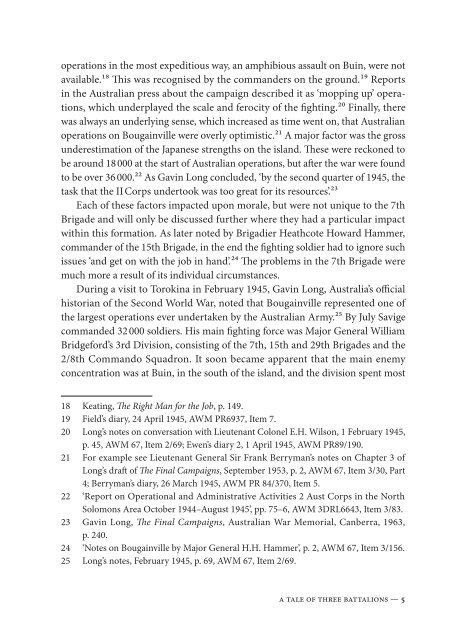View the pdf - Australian Army
View the pdf - Australian Army
View the pdf - Australian Army
Create successful ePaper yourself
Turn your PDF publications into a flip-book with our unique Google optimized e-Paper software.
operations in <strong>the</strong> most expeditious way, an amphibious assault on Buin, were notavailable.18 This was recognised by <strong>the</strong> commanders on <strong>the</strong> ground.19 Reportsin <strong>the</strong> <strong>Australian</strong> press about <strong>the</strong> campaign described it as ‘mopping up’ operations,which underplayed <strong>the</strong> scale and ferocity of <strong>the</strong> fighting.20 Finally, <strong>the</strong>rewas always an underlying sense, which increased as time went on, that <strong>Australian</strong>operations on Bougainville were overly optimistic.21 A major factor was <strong>the</strong> grossunderestimation of <strong>the</strong> Japanese strengths on <strong>the</strong> island. These were reckoned tobe around 18 000 at <strong>the</strong> start of <strong>Australian</strong> operations, but after <strong>the</strong> war were foundto be over 36 000.22 As Gavin Long concluded, ‘by <strong>the</strong> second quarter of 1945, <strong>the</strong>task that <strong>the</strong> II Corps undertook was too great for its resources’.23Each of <strong>the</strong>se factors impacted upon morale, but were not unique to <strong>the</strong> 7thBrigade and will only be discussed fur<strong>the</strong>r where <strong>the</strong>y had a particular impactwithin this formation. As later noted by Brigadier Heathcote Howard Hammer,commander of <strong>the</strong> 15th Brigade, in <strong>the</strong> end <strong>the</strong> fighting soldier had to ignore suchissues ‘and get on with <strong>the</strong> job in hand’.24 The problems in <strong>the</strong> 7th Brigade weremuch more a result of its individual circumstances.During a visit to Torokina in February 1945, Gavin Long, Australia’s officialhistorian of <strong>the</strong> Second World War, noted that Bougainville represented one of<strong>the</strong> largest operations ever undertaken by <strong>the</strong> <strong>Australian</strong> <strong>Army</strong>.25 By July Savigecommanded 32 000 soldiers. His main fighting force was Major General WilliamBridgeford’s 3rd Division, consisting of <strong>the</strong> 7th, 15th and 29th Brigades and <strong>the</strong>2/8th Commando Squadron. It soon became apparent that <strong>the</strong> main enemyconcentration was at Buin, in <strong>the</strong> south of <strong>the</strong> island, and <strong>the</strong> division spent most18 Keating, The Right Man for <strong>the</strong> Job, p. 149.19 Field’s diary, 24 April 1945, AWM PR6937, Item 7.20 Long’s notes on conversation with Lieutenant Colonel E.H. Wilson, 1 February 1945,p. 45, AWM 67, Item 2/69; Ewen’s diary 2, 1 April 1945, AWM PR89/190.21 For example see Lieutenant General Sir Frank Berryman’s notes on Chapter 3 ofLong’s draft of The Final Campaigns, September 1953, p. 2, AWM 67, Item 3/30, Part4; Berryman’s diary, 26 March 1945, AWM PR 84/370, Item 5.22 ‘Report on Operational and Administrative Activities 2 Aust Corps in <strong>the</strong> NorthSolomons Area October 1944–August 1945’, pp. 75–6, AWM 3DRL6643, Item 3/83.23 Gavin Long, The Final Campaigns, <strong>Australian</strong> War Memorial, Canberra, 1963,p. 240.24 ‘Notes on Bougainville by Major General H.H. Hammer’, p. 2, AWM 67, Item 3/156.25 Long’s notes, February 1945, p. 69, AWM 67, Item 2/69.A tale of three battalions — 5
















